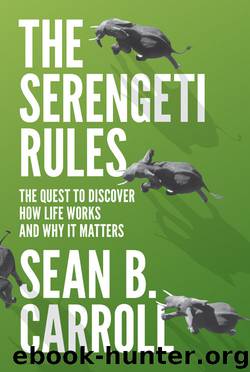The Serengeti Rules: The Quest to Discover How Life Works and Why It Matters by Sean B. Carroll

Author:Sean B. Carroll [Carroll, Sean B.]
Language: eng
Format: epub, azw3
ISBN: 9781400880263
Publisher: Princeton University Press
Published: 2016-02-16T07:00:00+00:00
FIGURE 7.3 The real drama of the Serengeti. The elimination of the rinderpest virus and increased consumption of grass by the exploding wildebeest population unleashed trophic cascades that increased the populations of predators, trees, giraffes, and other species.
Illustration by Leanne Olds.
FIGURE 7.4 The explosion of trees on the Serengeti. Reduced fires led to increases in tree density as monitored by photographs over a twenty-one-year period.
Photos courtesy of Anthony R. E. Sinclair.
Of all the changes triggered by the wildebeest boom, the “outbreak of trees” most surprised Sinclair. Like the connection between sea otters and kelp forests, the connection between rinderpest and trees involved multiple levels of negative regulation—in this case triple-negative logic, that were not obvious. Indeed, for decades, researchers and conservationists had been fretting over the disappearance of mature trees on the Serengeti and blamed elephants for their loss. The possibility that more young trees were regenerating had largely been overlooked.
But Sinclair was not satisfied with a good correlation. To test whether tree populations were in fact expanding on the savanna, he set up a series of camera points from which he documented the changes in tree populations. “It only took a decade,” he told me, to confirm that there was an “explosion” of several species of trees occurring across the Serengeti. [Figure 7.4]
On the treeless plains, the wildebeest have other important effects on plants besides fire suppression. Before their increase in numbers, the grass on the eastern plains grew to be fifty to seventy centimeters high. After their eruption, the grass grew to just ten centimeters. The shorter grass allows more light and nutrients for other plants, such that many more species of herbs grow. These herbs in turn support larger numbers and a more diverse community of butterflies.
Amazingly, the effects of the wildebeest and other grazers on the grasses are not entirely negative. Ecologist Sam McNaughton discovered that the major Serengeti grasses have adapted to the intense grazing by evolving a compensatory growth response that regenerates their above-ground parts. The grasses actually produce more food and are more abundant when grazed than when protected from grazing. In this fashion, the wildebeest positively regulate the formation of a dense “grazing lawn” that sustains them year after year (denoted by the symbol “↑ ” in the schematic below).
The wildebeest compete with other animals that also feed on the grass, such as grasshoppers. Both the number and diversity of grasshoppers decreased dramatically after the wildebeest boom, from more than forty species initially to about a dozen. Competition with wildebeest for food also appears to explain a reduction in the population of Thomson gazelles. In the four years during which the wildebeest population doubled, Sinclair and Norton-Griffiths found that the gazelle population had been reduced by half, from 600,000 to 300,000 animals. In contrast, the removal of buffalo from certain areas has revealed that they do not have such strong effects on other species.
Just like the mussels on rocky shores, the wildebeest are strong competitors for resources on the plains (denoted below
Download
The Serengeti Rules: The Quest to Discover How Life Works and Why It Matters by Sean B. Carroll.azw3
This site does not store any files on its server. We only index and link to content provided by other sites. Please contact the content providers to delete copyright contents if any and email us, we'll remove relevant links or contents immediately.
| Cell Biology | Developmental Biology |
| Entomology | Marine Biology |
| Microbiology | Molecular Biology |
| Biostatistics |
Sapiens: A Brief History of Humankind by Yuval Noah Harari(14319)
The Tidewater Tales by John Barth(12625)
Mastermind: How to Think Like Sherlock Holmes by Maria Konnikova(7278)
Do No Harm Stories of Life, Death and Brain Surgery by Henry Marsh(6905)
The Thirst by Nesbo Jo(6877)
Why We Sleep: Unlocking the Power of Sleep and Dreams by Matthew Walker(6654)
Life 3.0: Being Human in the Age of Artificial Intelligence by Tegmark Max(5512)
Sapiens by Yuval Noah Harari(5322)
The Longevity Diet by Valter Longo(5040)
The Body: A Guide for Occupants by Bill Bryson(5027)
The Rules Do Not Apply by Ariel Levy(4910)
The Immortal Life of Henrietta Lacks by Rebecca Skloot(4548)
Animal Frequency by Melissa Alvarez(4424)
Why We Sleep by Matthew Walker(4394)
The Hacking of the American Mind by Robert H. Lustig(4338)
Yoga Anatomy by Kaminoff Leslie(4332)
All Creatures Great and Small by James Herriot(4269)
Double Down (Diary of a Wimpy Kid Book 11) by Jeff Kinney(4240)
Embedded Programming with Modern C++ Cookbook by Igor Viarheichyk(4141)
